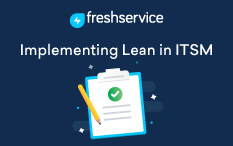Using ITIL with other Frameworks
When you’re getting an enterprise to function in a more lean and efficient way, there isn’t just one path to get there. Companies will often leverage ITIL and other frameworks together to support their holistic organizational needs. Each framework has their own scope and unique approach which can be helpful in addressing your organization’s unique challenges. Some of the common frameworks implemented alongside ITIL include:
ISO 20000
Although there is no formal relationship between ISO 20000 and ITIL, ISO 20000 clearly draws on ITIL principles. The ISO/IEC 20000:2005 version of the standard, was designed to be aligned with (then current version) ITIL V2. ITIL V3, published in 2007 was intended to achieve even better alignment with ISO 20000. Although not explicitly stated in ISO2000 standard, preparing an IT organization for ISO 20000 certification typically involves introducing ITIL principles.
COBIT
It is an IT governance framework and supporting toolset developed by ISACA. ISACA views ITIL as being complementary to COBIT with COBIT as providing a governance and assurance role while ITIL providing guidance for service management.
The Business Process Framework (eTOM)
published by the TeleManagement Forum offers a framework aimed at telecommunications service providers. In a joined effort, TeleManagment Forum and itSMF developed an Application Note to eTOM (GB921) that shows how the two frameworks can be mapped to each other. It addresses how eTom process elements and flows can be used to support the processes identified in ITIL.
FitSM
is a standard for lightweight service management whose process framework is quite similar to that of ISO 20000 and the Service Support and Service Delivery parts of ITIL Version 2, but adopts Service Portfolio Management from later ITIL versions.
DevOps
Isn’t a framework as much as a change of culture. DevOps uses the approach of cross-functional teams, encouraged to experiment, fail and learn and enabled by open communication. This addresses a key criticism of ITIL - teams working in silos with an “it’s not my issue” attitude. There is no “one size fits all” with DevOps because the framework brings together a looser set of principles that are integrated depending on the organization’s needs.
SAFe
(Scaled Agile Framework) allows you to apply the same Agile structure as you use with software development teams to an enterprise by scaling Agile on a larger applications. SAFe enables ‘teams of teams’ and a single view of the entire process. SAFe and other Agile frameworks do not conflict with ITIL processes but often the speed of process execution and the software being used by the organization result in some ITIL activities being perceived as overly cumbersome.
IT4IT Reference Architecture
from The Open Group is a reference architecture and supporting guidelines for managing the business of IT. It uses a value chain approach to create a model of the functions that IT performs to help organizations identify the activities that contribute to business competitiveness. IT4IT covers a similar general scope as ITIL however it does so with a focus on the technical capabilities needed to support the IT function instead of the processes and activities described by ITIL
These frameworks compete when people take them literally and use prescriptive solutions, however, they can be complementary when used as guidelines and best practices that are adapted to your unique needs. The most common combinations are ‘DevOps and ITIL’ and ‘COBIT and ITIL’, but other combinations can work well too. Before you throw out any process or frameworks you already have, consider whether there is an opportunity for a multi-framework solution that provides a best-of-breed solution.















